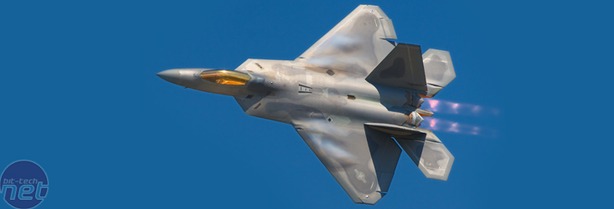
Tough tech in the air
While in certain situations, computers benefit from keeping things simple, there are advantages to more complex systems, and modern fighter planes such as the F-22 and the Eurofighter are excellent examples of this. Almost all modern aircraft are fly-by-wire (FBW) designs, which means that they're effectively flown by computers relaying the actions of the pilot to the plane's control surfaces.What makes the Eurofighter special is that the computers have to do much more than simply interpret what the pilot does. This is because the Eurofighter is a 'relaxed stability' design - this makes it more manoeuvrable, but it has unstable flight characteristics, so much so that a human pilot simply can't fly it unaided.
Sensors keep tabs on the Eurofighter while it's in flight and these feed information into the FBW computers; these computers then make constant, minute adjustments to the control surfaces of the plane. The US F-117A Nighthawk is another example of a 'relaxed stability' design - in this case, the use of computer systems to keep it in the air enables it to utilise a distinctive shape which makes it difficult for radar systems to detect.
The Eurofighter has four FBW computers, each with eight 32-bit Motorola 68020 CPUs (a design dating from the mid-1980s, versions of which were originally used in the Apple Macintosh II, as well as Amiga's CD32 console). The use of older CPUs in aircraft (and spacecraft) is a well-documented practice, owing to the fact that the older the design, the more likely the inevitable bugs will have been worked out.

The F-22 uses FireWire to connect its internal computer systems
That said, computers still go wrong. Although computerised weapons platforms going crazy and deciding to blow up their creators is the stuff of which movies are made (very often really bad ones such as Stealth), the reality is that what to the average PC user might just be a blue-screen of death, on board a plane, it could be a situation requiring a change of underpants or worse.
Computer crashes of this type have been a rare, yet notable, problem with the F-22 Raptor fighter. The most bizarre incident (which thankfully resulted in no loss of life) was during a flight made by six Raptors to Okinawa in 2007, which saw all six aircraft suffer multiple system crashes when crossing the 180th meridian of longitude.
Although the aircraft were able to continue to fly and landed safely, all six lost navigation and communication abilities as a result of the crashes and had to be escorted home. This event shows the importance of using separate systems for critical components, but more importantly, it shows that even in multi-billion dollar defence projects, you can still find the same sort of bugs you might expect in a newly released computer game.

MSI MPG Velox 100R Chassis Review
October 14 2021 | 15:04








Want to comment? Please log in.